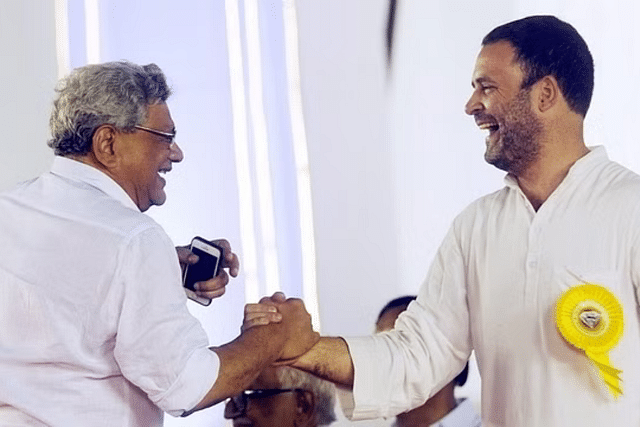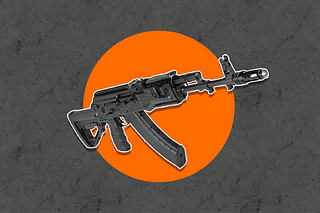Politics
The Centre-Left Space In Indian Politics Is Vacant, And There Are No Candidates To Apply!
Banuchandar Nagarajan
May 10, 2024, 12:45 PM | Updated 12:45 PM IST
Save & read from anywhere!
Bookmark stories for easy access on any device or the Swarajya app.

Rahul Gandhi, with his repeated comments on division and redistribution of wealth has given the communists a run for their money.
He has pushed the Congress party to the extreme left, and has pried open the centre-left space in Indian politics.
Whether Rahul Gandhi has been unhinged, incompetent or deliberate about his utterings is anybody's guess. But, arguably being the most powerful leader in the party, his words have to be taken to represent the values of the Congress.
(Before we get anywhere into this article, let's put a pause on the contention that there is no strict left and right in Indian politics and these are strictly western paradigms).
In social choice theory, the ‘median voter theorem’ is used to explain how groups make collective choices.
Applied to politics, it assumes that the voters are distributed in something like a normal distribution curve, with majority of the voters being clumped in the middle, while the extremists of the right and left are at the far ends of the curve.
The theorem explains that the party that espouses values that are close to the median (centre of the curve) usually wins, as more people are able to relate to those values.
Centrism, towards the left or the right, is usually palatable to a majority of voters in a ‘first past the post’ system.
In Indian politics, the Bharatiya Janata Party (BJP) has positioned itself in the right-of-centre space in the cultural dimension.
On the economic dimension, the BJP has followed both input-based and output-based policies, offering both incentives and freebies, thereby placing itself in the middle.
It is safe to conclude that, collectively, the BJP has taken over the right of the ideological spectrum and has made serious inroads into the centre-left space as well.
The centre-left space has historically been occupied by the Congress. Many regional parties occupy this space too.
But, it is very difficult to place them collectively on one side or the other. When we are looking at national politics, a coalition of such entities, offer no clear ideological signal to the voters.
As mentioned in the beginning, over the last one month of election campaign, it is very clear that the Congress has moved to the extreme. The kind of distributive politics that the Congress has been proposing is just one aspect.
The appeasement of the minorities that the Prime Minister and BJP campaigners have been pointing out, shows that the Congress has pushed itself to the extreme left in the cultural aspect also.
It competes with AIMIM, AIUDF, RJD, SP, DMK, CPI-M, Muslim League etc, for minority votes (it partners with some of these entities to collectivise minority votes).
Perhaps, this competition is the reason for the Congress moving away from being a big-tent GOP that it was in the past.
Old fox, Sharad Pawar has sensed this gap. He knows that to be able to compete with the BJP, there needs to be a strong centre-left party that is amenable to the majority of the population, if they have to give themselves any chance of competing with the BJP in national elections.
He has said that the old mothership Congress should be reconstituted with factions that had broken away over the last few decades. (There is also a self-serving aspect of him ensuring the political future of his daughter, Supriya Sule, post his impending retirement).
Now, that is theoretically elegant. But, to erect a pole opposing the BJP is going to take decades of work. The troika of ideology, organisation and leadership coming together at India scale will be an incredibly tough undertaking.
When the BJP was trying to establish itself as the competitor to the Congress in the 1980s and 1990s, it had Hindutva or cultural nationalism as the ideological ballast and dedicated field-support from RSS (Rashtriya Swayamsevak Sangh) volunteers as the organisational scaffold.
Whenever, BJP has fixed the leadership problem (the third aspect), both at state-level and central level, it has come out trumps. Since 2014, with an all-powerful leader in Prime Minister Narendra Modi, the BJP has scored big in all three aspects. PM Modi and Home Minister Amit Shah have further strengthened the organisation and ideology, thereby setting BJP up for political domination.
The Congress has been an arbiter of political interests rather than an ideology-based party. It did not bother to craft an elegant and concrete ideology over the years.
They profess a few isms — federalism, secularism, liberalism — etc, but they do not form an emotional whole that could animate people.
On organisation and leadership aspects, it has lived off its legacy as the party that led the freedom movement.
Historians have chronicled it the many waves in Indian democracy — 1967, 1977, 1989 and 1996 — during which the Congress has lost cadres and leaders to regional parties (which Sharad Pawar want to cobble back). 2014 and 2024 should be added to the list of pivotal moments when the Congress has denuded.
It is quite surprising that the Congress, which boasts of having so many ‘intellectuals’ on their side, has not come up with new ideas that are pertinent to the times and have captured the attention of people.
Over the last 10 years, the liberal intelligentsia have been regurgitating old ideas through tiresome op-ed columns. The much touted ‘NYAY’ of the 2019 manifesto of the Congress is anything but novel.
It was a repacking of stuff that was already in execution.
Perhaps, the seemingly cool English-speaking elites that hold the fort in the Congress, having been exposed for their banality have become intellectually insecure against the very people that they deemed as inferior.
The current Congress manifesto is an example of the above phenomenon. To say that it lacks a punch is an understatement. It lacks intellectual depth, attractive ideas and cogency.
It is filled with bromides on the one end (check the economic section) and fiscally profligate (or absolutely unimplementable) ideas of giving free employment to the youth and free money to women.
Had the left-liberal ecosystem put their minds to work to refine the core concepts, the aforesaid isms — federalism, secularism, liberalism — in a way that is practical and progressive, instead of continuously outraging against Prime Minister Modi, at least they would have given themselves a chance to compete in the realm of ideas.
The last decade is a lost opportunity for them. And thus lies vacant the centre-left space in Indian polity.
Save & read from anywhere!
Bookmark stories for easy access on any device or the Swarajya app.
Banuchandar is a political and public policy advisor. He posts at @Banu4Bharat.
Support Swarajya's 50 Ground Reports Project & Sponsor A Story
Every general election Swarajya does a 50 ground reports project.
Aimed only at serious readers and those who appreciate the nuances of political undercurrents, the project provides a sense of India's electoral landscape. As you know, these reports are produced after considerable investment of travel, time and effort on the ground.
This time too we've kicked off the project in style and have covered over 30 constituencies already. If you're someone who appreciates such work and have enjoyed our coverage please consider sponsoring a ground report for just Rs 2999 to Rs 19,999 - it goes a long way in helping us produce more quality reportage.
You can also back this project by becoming a subscriber for as little as Rs 999 - so do click on this links and choose a plan that suits you and back us.
Click below to contribute.





